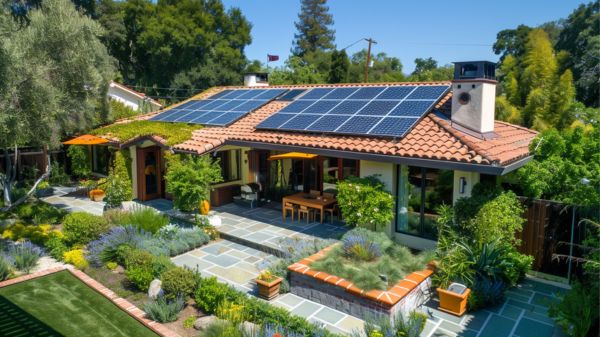As the search for sustainable energy solutions gains traction, homeowners are increasingly switching to solar power technologies to lessen their carbon footprint and energy expenses. This guide will be discussing the best solar power technologies for homes and the critical distinctions between Photovoltaic (PV) and Concentrated Solar Power (CSP) systems, and the importance of evaluating roof suitability for efficient solar panel installation.
With advancements such as the PVWatts calculator providing accurate energy production estimates, and the requirement to involve NABCEP-certified professionals, the journey towards effective solar energy utilization is more achievable than ever. What factors should you consider to optimize your home’s solar potential?
Key Takeaways
- Assess roof suitability and engage NABCEP-certified installers for optimal solar panel installation.
- Utilize PVWatts calculator to estimate potential energy production and financial savings.
- Explore financial incentives like the Solar Investment Tax Credit and local subsidies to reduce costs.
- Consider community solar solutions and EnergySage to find shared solar projects.
- Enhance system efficiency and aesthetics with Building-Integrated Photovoltaics (BIPV) and advanced energy storage options.
Solar Technology and Installation
When considering solar technology for residential properties, it is important to understand the distinctions between photovoltaics (PV) and concentrating solar power (CSP), as well as the specific installation requirements and suitability of PV panels for home use.
Photovoltaics (PV) absorb sunlight to generate electricity directly, making them ideal for residential applications. In contrast, CSP utilizes mirrors to concentrate sunlight, primarily fitting for large-scale power plants.
The suitability of a roof for solar panels is crucial. Various climates can support solar power, but excessive shade or structurally unsuitable roofs may pose challenges. Utilizing advanced mapping services can accurately assess roof suitability, ensuring optimal energy generation.
It is advisable to engage NABCEP-certified professionals for the installation of solar panels. Their expertise ensures adherence to industry standards, maximizing efficiency and safety.
Moreover, tools like NREL’s PVWatts calculator provide precise estimates of energy production and costs, fostering informed decision-making. As the solar technology landscape evolves, embracing these innovations empowers homeowners to harness clean energy effectively.
This liberation from traditional energy sources not only promotes sustainability but also aligns with a future-focused, data-driven approach to residential energy needs.
Financial Incentives and Options
Exploring the myriad of financial incentives and options available for solar installations can greatly enhance the affordability and attractiveness of renewable energy investments for homeowners. With the right financial strategy, shifting to solar power can be both economically beneficial and environmentally responsible.
Several key financial mechanisms can make solar installation more feasible:
- Solar Loans: These specialized loans reduce the upfront costs of solar installations, allowing homeowners to finance their systems over time. This makes it easier to start saving on energy bills immediately.
- Solar Investment Tax Credit (ITC): The ITC enables homeowners to claim up to 26% of the total cost of their solar systems as a tax credit, significantly lowering the overall expense. This federal incentive has been instrumental in driving the adoption of residential solar.
- Subsidized Loans with Below-Market Interest Rates: These loans offer additional financial benefits by providing access to funds at reduced interest rates. Often supported by government programs, they make investing in solar energy more affordable.
Additionally, mortgage inclusion allows homeowners to incorporate the cost of solar systems into their home loans, distributing the financial burden over the mortgage term.
Utilizing resources like the DOE’s Homeowners Guide and DSIRE can help identify local incentives and tax breaks, maximizing the financial benefits of your solar investment.
Related Post: 5 Best Government Solar Incentives for Homeowners.
Community Solar Solutions
Community solar solutions offer a scalable and cost-effective approach to renewable energy by allowing multiple participants to share the benefits of a single solar array, thereby reducing individual financial burdens and increasing accessibility.
By participating in community solar projects, homeowners and renters alike can leverage the collective power of shared solar arrays without the need for personal rooftop installations. Tools like EnergySage facilitate the process by enabling individuals to find and compare community solar projects tailored to their needs and budgets.
Third-party owned systems, which are common in community solar setups, have been shown to have a neutral impact on home sales price and time on the market, making them an attractive option for those concerned about property values. Solar leases and Power Purchase Agreements (PPAs) further democratize access to solar energy systems by permitting consumers to host solar arrays owned by solar companies, typically involving fixed monthly payments based on estimated electricity production.
The growing adoption of community solar signifies a shift towards more inclusive renewable energy solutions, empowering participants to contribute to a sustainable future. This model not only fosters energy independence but also promotes broader engagement in the progression to clean energy sources.
Related Post: Community Solar Program: Clean Energy for All.
Regulatory Considerations and Net Metering
As homeowners increasingly adopt solar power technologies, understanding the regulatory landscape and net metering policies becomes crucial to optimize financial and environmental benefits.
Net metering allows solar panel owners to receive compensation for the excess solar power they export to the grid. This pivotal mechanism varies significantly by state and utility practices, making it essential for homeowners to be well-informed.
To navigate these complexities effectively, homeowners should consider the following:
- State Requirements: Different states have varying regulations regarding solar power and net metering. Researching state-specific policies ensures compliance and maximizes potential benefits.
- Utility Practices: Individual utility companies may have unique practices regarding net metering, affecting the compensation rates and the overall financial viability of solar installations. Understanding these practices can lead to more informed decisions.
- Compensation Mechanisms: Net metering policies determine how excess solar energy is credited. Familiarity with these mechanisms enables homeowners to better predict their return on investment and plan their energy usage accordingly.
Solar Aesthetics and Storage
Incorporating Building-Integrated Photovoltaics (BIPV) and advanced energy storage systems into residential solar installations significantly enhances both the aesthetic appeal and functional efficiency of solar power technologies for homeowners. BIPV technology seamlessly integrates solar panels with home aesthetics, ensuring that harnessing solar energy does not compromise visual appeal. This integration is pivotal for homeowners who value both sustainability and the architectural integrity of their homes.
Energy storage, particularly through battery storage systems, revolutionizes solar energy usage. These batteries store excess solar energy generated during peak sunlight hours, providing a reservoir of power for use during periods of low sunlight or at night. This not only enhances energy independence but also optimizes the efficiency of the residential solar power system.
By consulting with solar installers, homeowners can explore tailored battery storage solutions that align with their energy needs and home aesthetics. With the flexibility to utilize stored solar power as needed, reliance on the grid diminishes, paving the way for a more self-sufficient and eco-conscious living environment.
Properly integrated solar aesthetics and storage solutions are not merely functional enhancements; they are the cornerstone of a forward-thinking approach to sustainable living, maximizing the benefits of advanced solar power technologies.
Conclusion
In the quest for sustainable energy solutions, understanding the nuances of PV and CSP systems is crucial. Engaging NABCEP-certified professionals and utilizing tools like the PVWatts calculator are essential steps in the process. Financial incentives, community solar options, and regulatory frameworks further enhance the feasibility of solar adoption.
As solar technology advances, integrating aesthetic considerations and energy storage solutions will be vital for optimizing residential solar energy systems. This will drive the future of renewable energy adoption among homeowners.




